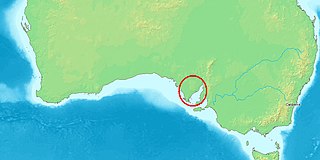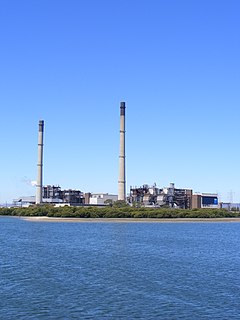
Protected areas of South Australia consists of protected areas located within South Australia and its immediate onshore waters and which are managed by South Australian Government agencies. As of March 2018, South Australia contains 359 separate protected areas declared under the National Parks and Wildlife Act 1972, the Crown Land Management Act 2009 and the Wilderness Protection Act 1992 which have a total land area of 211,387.48 km2 (81,617.16 sq mi) or 21.5% of the state's area.

The Spencer Gulf is the westernmost and larger of two large inlets on the southern coast of Australia, in the state of South Australia, facing the Great Australian Bight. It spans from the Cape Catastrophe and Eyre Peninsula in the west to Cape Spencer and Yorke Peninsula in the east.

The Government of South Australia, also referred to as the South Australian Government, SA Government or more formally, Her Majesty’s Government, is the Australian state democratic administrative authority of South Australia. It is modelled on the Westminster system of government, which is governed by an elected parliament.

The Tasmanian giant crab, Pseudocarcinus gigas is a very large species of crab that resides on rocky and muddy bottoms in the oceans off Southern Australia. It is the only species in the genus Pseudocarcinus.
Dziwneono (subfamily:Typhlocybinae) is a genus of Australian leafhoppers, with more than ten undescribed species. It's been described in 1972 by Polish entomologist Irena Dworakowska.

Plebidonax deltoides or Donax deltoides is a small, edible saltwater clam or marine bivalve mollusc, endemic to Australia. It belongs to the family of either the Donacidae, or the related Psammobiidae. It is most widely known as the pipi in the eastern states of its native Australia. In South Australia, it is called the Coorong cockle, Goolwa cockle, or Goolwa pipi, for the region where it is most abundant, or by its Ngarrindjeri name, kuti. In south-eastern Queensland, it is often also known as eugarie or (y)ugari, a borrowing from the local Yugambeh and Ugarapul languages.

Mallee are trees or shrubs, mainly certain species of eucalypts, which grow with multiple stems springing from an underground lignotuber, usually to a height of no more than 10 m (33 ft). The term is widely used for trees with this growth habit across southern Australia, in the states of Western Australia, South Australia, New South Wales and Victoria, and has given rise to other uses of the term, including the ecosystems where such trees predominate, specific geographic areas within some of the states and as part of various species' names.

Para Wirra Conservation Park is a 1,417-hectare (3,500-acre) protected area located in the foothills of the Mount Lofty Ranges in the northern end of the Adelaide metropolitan area in South Australia. The conservation park is part of a larger, 2,573-hectare (6,360-acre) block of contiguous native vegetation, the remainder of which is owned by PIRSA Forestry, SA Water and private landholders.

Torrens Island is an island in the Australian state of South Australia located in the Adelaide metropolitan area in the Port River Estuary about 15 kilometres (9.3 mi) northwest of the Adelaide city centre. Since European settlement of Adelaide in 1836, it has been used for a number of purposes.
National biosecurity in Australia is governed and administered by two federal government departments, the Department of Health and the Department of Agriculture, Water and the Environment. The Biosecurity Act 2015 and related legislation is administered by the two departments and manages biosecurity risks at the national border. The Act aims to manage biosecurity risks to human health, agriculture, native flora and fauna and the environment. It also covers Australia's international rights and obligations, and lists specific diseases which are contagious and capable of causing severe harm to human health. Each state and territory has additional legislation and protocols to cover biosecurity in their jurisdiction (post-border).

Pelican Lagoon Conservation Park is a protected area located in the Australian state of South Australia on the Dudley Peninsula on Kangaroo Island. It was dedicated in 1967 for the protection of wildlife habitat.

Pelican Lagoon is a seawater lagoon in the Australian state of South Australia located on the north coast of Kangaroo Island about 18.7 kilometres south east of Kingscote. It was named by Matthew Flinders on 4 April 1802 after the large population of pelicans present in its waters and adjoining shorelines. Its role as fishery hatchery had been identified by the early 20th century with the result that fishing in its waters has been restricted in varying degrees.

Eurymela distincta is a species of leafhopper native to the Australian continent. It has a wedge-shaped body that is 10–12 mm long or 12–14 mm long. The head is black with cream or white maxillary plates. The pronotum and scutellum are black. The tegmen is black with a blue or purple tinge, and one to three white fasciae. The costal margin is black. Legs are scarlet close to the body and black further away. Underparts are scarlet.

Eurymela fenestrata, widely known as the common jassid and sometimes as the large gum treehopper, is a species of leafhopper found throughout mainland Australia.

Point Labatt is a headland located on the west coast of Eyre Peninsula in the Australian state of South Australia about 39 kilometres south by east of Streaky Bay. It is notable as one of the largest Australian mainland breeding sites for Australian sea lions. The land and the sea adjoining Point Labatt is part of three protected areas - the Point Labatt Conservation Park, the Point Labatt Aquatic Reserve and the West Coast Bays Marine Park.
Winninowie Conservation Park is a protected area in the Australian state of South Australia located on the east coast of Upper Spencer Gulf about 20 kilometres south by east of Port Augusta and 25 kilometres northwest of Port Germein, in the locality of Miranda. The conservation park was proclaimed in 1990 for the purpose of conserving ‘excellent examples of several coastal and marine ecosystems with sub-tropical affiliations in a temperate environment’ including ‘significant stands of the grey mangrove, Avicennia marina var. resinifera, seagrass and samphire salt marsh communities’. The conservation park's boundaries overlap with those of the Yatala Harbour Upper Spencer Gulf Aquatic Reserve. The conservation park is classified as an IUCN Category Ia protected area.
South Australian Forestry Corporation is a business enterprise owned by the Government of South Australia which is responsible for management of publicly owned plantation forests in South Australia including the commercial production of timber and the management of forests for non-commercial purposes such as community use and as protected areas.

American River Aquatic Reserve was a marine protected area in the Australian state of South Australia located on the north coast of Kangaroo Island in waters of the coastal lagoon known as Pelican Lagoon, in existence from 1971 to 2016. From 2012, the Pelican Lagoon Sanctuary Zone has fallen within the Encounter Marine Park. Pelican Lagoon is probably the oldest marine protected area in South Australia, having been protected since 1914.
Primary Industries and Regions SA (PIRSA), also known as Primary Industries and Regions South Australia, and the Department of Primary Industries and Regions SA, is an agency of the South Australian Government whose focus is the economic development of the state of South Australia. Its key areas of work include primary sector industries, and biosecurity.













